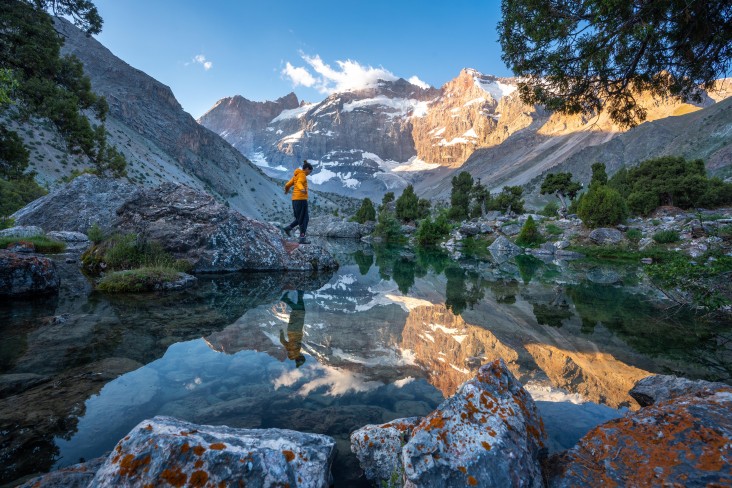Speeches Shim

USAID is Strengthening Economic Development by Training Local Entrepreneurs in the Tourism Industry
Prior to the COVID-19 pandemic, tourism was one of the fastest-growing sectors globally. Recognizing the unique heritage and availability of unspoiled landscapes, the governments of Central Asia identified tourism as a sector to develop and have been facilitating investment in hotels and transport.
USAID started supporting sustainable tourism in Central Asia in 2014 to improve economic diversification and increase employment in the sector across the region. Each country used to approach tourism development individually, and USAID’s efforts supported them as a region and helped to broaden cooperation in this area.
After nearly a decade, Uzbekistan reopened its borders with Tajikistan in 2018. It was a significant development for the tourism industry. As a result of open borders and an improving relationship between the two countries, international tourists could more easily visit both countries.
Zafar Norov was motivated to open the first hostel in Panjakent city, Tajikistan, at the entrance to Zaravshan Valley when it became possible for international tourists to combine a visit to Samarkand in Uzbekistan with a trip to the famous Fann Mountains in Tajikistan less than 50 miles away.
Zafar, who lives with his family in Panjakent, is an active member of the Zaravshan Tourism Board. In 2018, he attended a training session through USAID’s Competitiveness, Trade, and Jobs program where he learned the importance of creating and maintaining an online presence for his new business, Salom Hostel.
In one year, starting in 2019, USAID trained the owners of more than 100 boutique hotels, guesthouses, yurt camps, homestays, and hostels across Central Asia on how to register their businesses online and understand how online booking fits into the overall management of their operations.
After USAID’s training in Panjakent, 16 new guesthouses joined Booking.com. Platforms such as Booking.com, Airbnb.com, Agoda.com, and others play an important role in facilitating guest management and bookings, especially in remote and lesser-known areas.
Before the training, Zafar accommodated 218 tourists at his hostel in 2018. Skills learned at the USAID training and one-on-one consultations helped Zafar increase bookings and improve the guest experience. Last year, 350 people enjoyed their stay in Zafar’s hostel, and his guest review rating increased from 8.5 to 9 out of 10.
Eraj Muhammadzhon-Zade also attended training workshops offered by USAID. He is passionate about adventure tourism and manages ARTUCH AlpCamp Mountain Climbing Center, high in the Fann Mountains in northwest Tajikistan. ARTUCH was a famous Soviet climbing center that Eraj has converted into a lodge for mountain climbers and hikers.
Eraj applied lessons learned from USAID’s online marketing workshop to maximize the visibility and interest of potential customers to reserve accommodation at his lodge via Booking.com.
In August 2019, USAID organized a group of tourism social media influencers to visit Central Asia. Ten international travel bloggers from Australia, Belgium, Germany, India, Italy, and the U.S. were divided into two groups: one group traveled to Kazakhstan and the Kyrgyz Republic, the second group visited Tajikistan and Uzbekistan. Travel bloggers spent three nights at ARTUCH exploring the Fann Mountain area and hiking around the Kulikalon Lakes.
Eraj reported a notable uptick in travel inquiries last fall and winter following the bloggers’ posts, which reached 4 million viewers over the past year. Although these plans have been deferred due to COVID-19, he hopes that the publicity that captured the attention of so many people will motivate them to plan to travel to his mountains after the pandemic ends.
Despite the travel and tourism industry being hit hard due to ongoing COVID-19 related travel restrictions and border closures, Eraj and Zafar are optimistic and are preparing for the 2021 tourist season. Eraj noted that the international guests he expected this year largely postponed their trips to 2021 rather than canceling them outright. He has been testing and refining new hiking trails and offering them to local tourists over the summer to be ready with an expanded range of activities to offer next season’s travelers. Zafar has spent the COVID-19 quarantine modernizing his hostel rooms and testing new trails to offer his guests in 2021.
In collaboration with national and regional tourism groups, USAID’s efforts to develop and promote sustainable tourism in Central Asia have elevated the region’s position on the global tourism market. Popular travel guides such as Lonely Planet highlighted ecotourism hub Jyrgalan in the Kyrgyz Republic as a direct result of USAID’s efforts and ranked the Central Asian Silk Road as the best region in the world to visit in 2020.
Through familiarization tours for travel bloggers and tour operators, tourism trade fairs, and social media campaigns, USAID helps create opportunities for Central Asian tourism businesses to improve their understanding of international tourists, connect to foreign markets, and expand product offerings.
The latest data indicates that employment in the travel industry across Central Asia has increased by about 7% since 2014. USAID aims to further improve economic diversification and increase employment in the sector across the region.
The World Travel & Tourism Council noted that the tourism industry will be the key sector in driving the recovery of the global economy post COVID-19 by generating new jobs and driving visitors back to destinations.
After the pandemic ends, Central Asian tourism businesses will be ready to greet international tourists again. In the meantime, USAID is helping to make a positive impact on domestic tourism so that locals can safely discover area tourism gems.

Comment
Make a general inquiry or suggest an improvement.